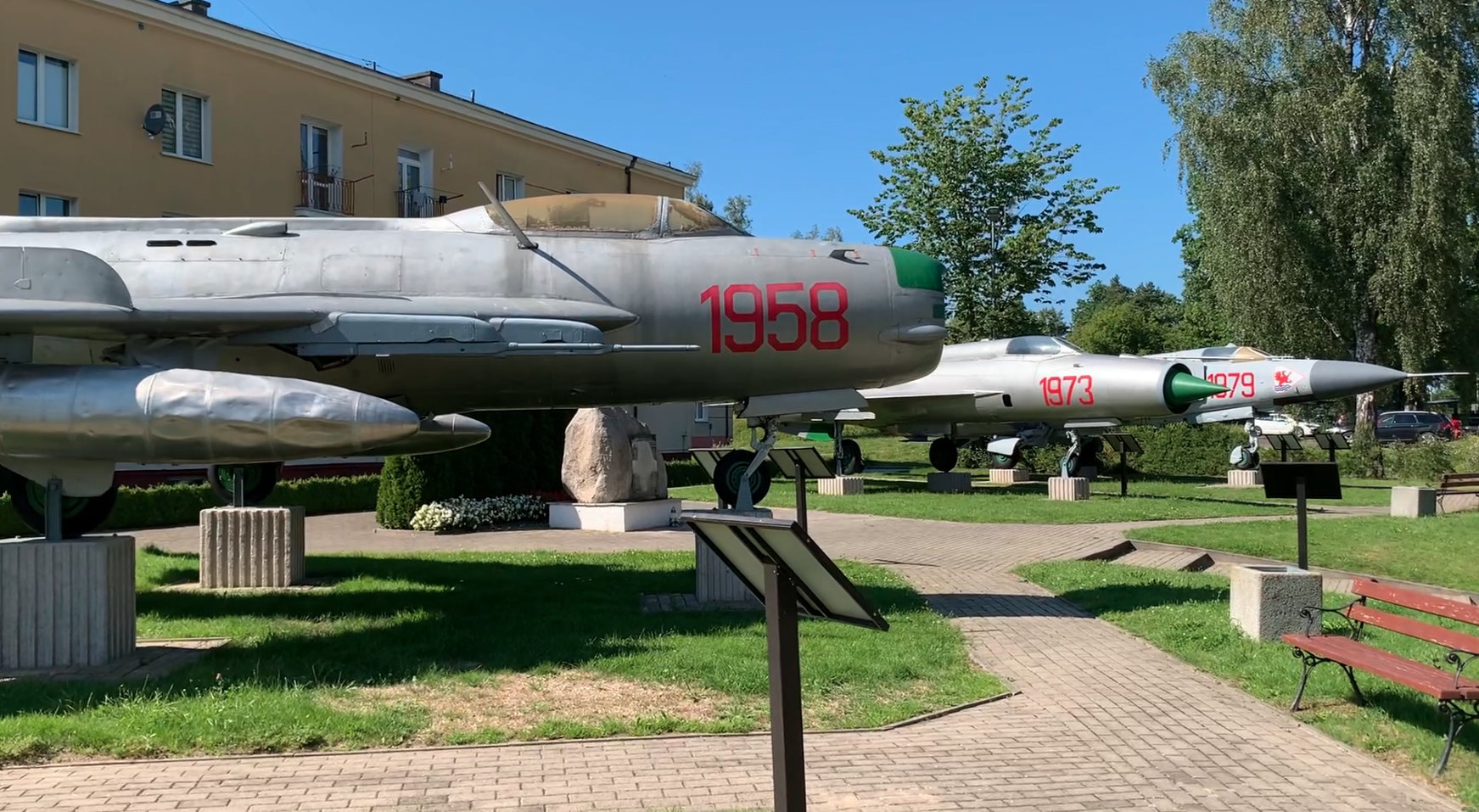Redzikowo 2024-08-24
As long as the participants who made history are alive, the memory of the 28th Słupsk Fighter Aviation Regiment will remain alive.
The 28th Fighter Aviation Regiment is formed. September 17, 1952.
The 28th Fighter Aviation Regiment was formed on the basis of the Order of the Ministry of National Defense No. 0096 of December 11, 1951, and the Order of the Commander of the Air Force No. 018 of May 21, 1952, on the basis of the existing 10th Fighter Aviation Division in Redzikowo near Słupsk. The deadline for achieving combat readiness was set for November 1, 1952.
On September 15-16, 1952, a group of 10 MiG-15 and MiG-15 UTI aircraft was redeployed from the Bemowo airport to Redzikowo. This group was commanded by Major Pilot Wasyl Krymski. The regiment immediately began training on modern MiG-15 fighter aircraft and never had Yak-17 and Yak-23 fighters in its inventory. On September 17, 1952, the first muster of the 28th Fighter Aviation Regiment took place, consisting of 62 officers and 142 non-commissioned officers and privates. That day, September 17, 1952, was considered the date of the establishment of the 28th Fighter Aviation Regiment in Słupsk, which was so strongly connected with the city that years later it received its own name, the 28th Słupsk Fighter Aviation Regiment.
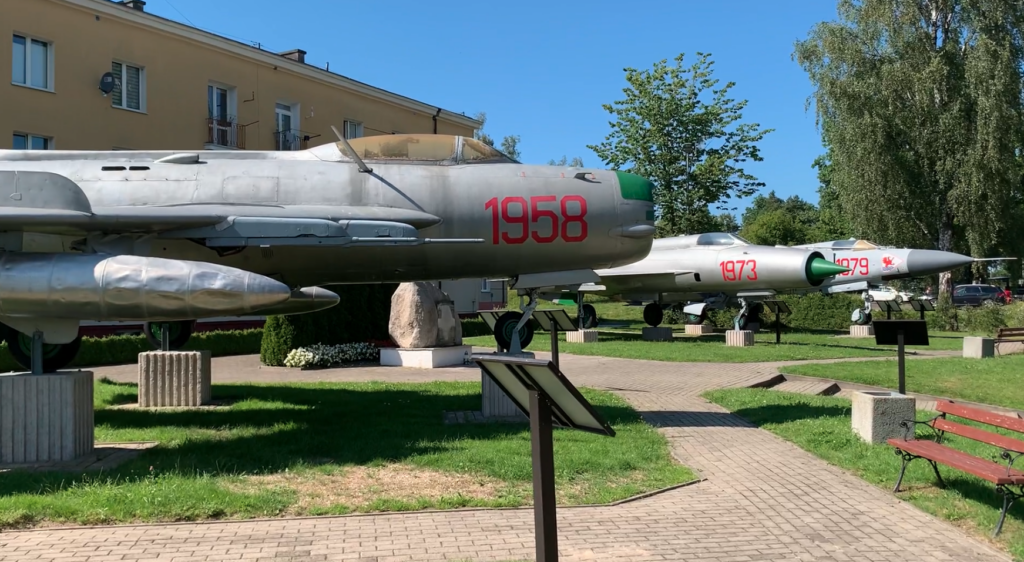
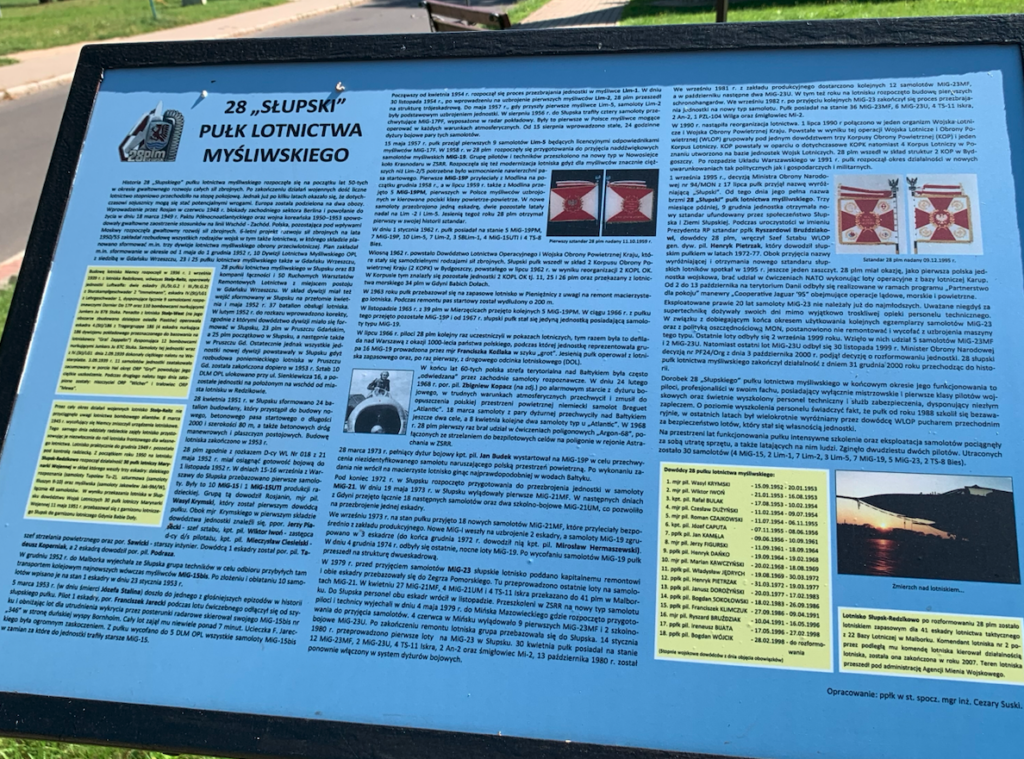
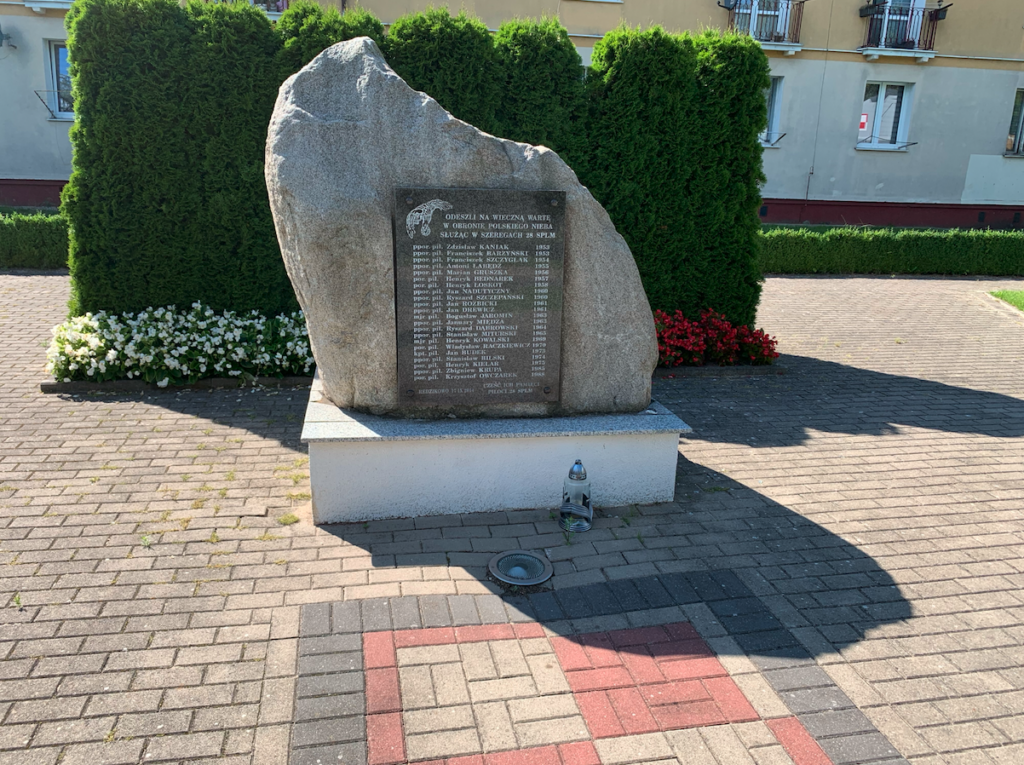
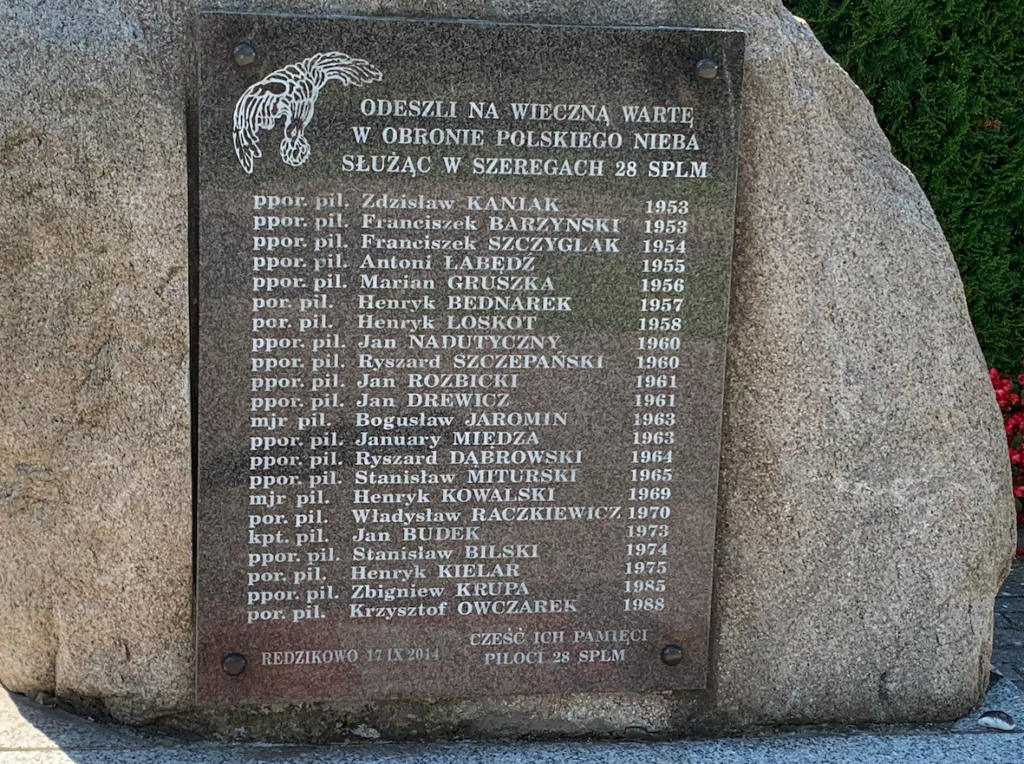
1953
The 28th Regiment, as the leading one in the 10th DLM, was always the first to receive new equipment. Already in 1953, the first MiG-15 bis fighters were introduced to the Regiment. This action was evidence of the important role of the 28th PLM in the Polish defense system. At the beginning of 1953, the first Polish-made Lim-1 fighter planes, equivalent to the Soviet MiG-15, also began to reach the Regiment.
From the first days of its existence, the main task of the 28th Regiment was flight training and defense of the most important administrative and economic facilities of Poland, as well as troops on the Central Coast. The implementation of this task was subordinated to organizational and staff changes in the Regiment, systematic replacement of aviation equipment and continuous expansion of the airport’s ground infrastructure.
1956
In 1956, the basic type of fighter were Lim-1, MiG-15, Lim-2, MiG-15 bis. In 1956, the first fighters equipped with radar stations were brought to Poland. These were 12 MiG-17 PF machines. It was decided to introduce these fighters in a flight quantity into the equipment of three regiments deployed in the north of the country. One of the regiments was the 28th PLM in Słupsk. In December 1956, a flight of MiG-17 PF pursuit aircraft was organized.
MiG-19 in the 28th PLM. 1958
In the mid-1950s, it was known that the era of supersonic aircraft was coming. After many months of Polish diplomacy, they managed to obtain permission to purchase 33 supersonic MiG-19 P / PM fighters capable of flying in “all weather conditions”. The Ministry of National Defense decided to arm three fighter aviation regiments with these aircraft, in the amount of a squadron. One of them was the 28th PLM.
In 1958, the 28th PLM began preparations for the introduction of MiG-19 aircraft. A group of pilots and technicians was selected and trained at the CCCP in Nowosiejka near Krasnodar. The first MiG-19 P aircraft arrived at the 28th PLM from Modlin in early December 1958. In July 1959, 5 MiG-19 PM aircraft were also delivered from Modlin. One squadron was re-equipped with new aircraft, while the other two continued to fly Lim-2 and Lim-5 aircraft. In June 1959, 4 MiG-17 PF aircraft were transferred to the Operational Aviation regiments.
On January 1, 1962, the 28th PLM had; 5 MiG-19 PM aircraft, 7 MiG-19 P aircraft, 10 Lim-5 aircraft, 7 Lim-2 aircraft, 3 SB Lim-1 aircraft, 4 MiG-15 UTI aircraft, 4 TS-8 Bies aircraft.
On September 15, 1962, the 28th Regiment lost its first MiG-19 PM. Unfortunately, the pilot, Lieutenant Jan Drewicz, died in the crash.
In October 1964, the 28th PLM had; 10 MiG-19 P aircraft, 5 MiG-19 PM aircraft, 8 Lim-5 aircraft, 11 Lim-2 aircraft, 3 SB Lim-1 aircraft, 4 MiG-15 UTI aircraft, 4 TS-8 Bies aircraft.
In November 1965, five more MiG-19 PM aircraft were accepted from the 39th PLM in Mierzęcice. In 1966, several more MiG-19 P aircraft were accepted from the 39th PLM. This was in line with the MON’s policy to have the strongest units in northern Poland, directly bordering the “West”.
Unfortunately, in mid-1966, two MiG-19 PMs were lost in accidents. The first plane crashed on June 20, 1966, near the town of Lulemino. Pilot Major Raszewski survived. The second plane was lost exactly one month later, on July 20, 1966, in quite unusual circumstances. Second Lieutenant Pilot Zbigniew Kopacz, who was retraining for a new type of plane, accidentally activated the landing gear lever while still on the apron. The landing gear loaded with the plane did not retract immediately, but only during the take-off run. The plane began to scrape its nose against the runway and caught fire. The pilot managed to leave the cockpit, but the MiG-19 PM nb 910 plane burned down.
On June 16, 1967, a winch failure occurred in a landing Il-28 bomber from the 19th Towing Squadron, which caused the “Gacek” towed on a too long rope to deviate from the runway axis to the right and completely smash the front part of the MiG-19 P nb 1012 aircraft standing on the grass.
In 1970, another disaster occurred, and Lieutenant Władysław Raczkiewicz, piloting the MiG-19 P, died. The pilot did not have time to recover the aircraft from a dive during an attack on a ground target.
In 1970, the 28th PLM hosted a squadron of Hungarian MiG-19 S (the Hungarians fired at surface targets), while in July 1972, a squadron of Słupsk MiG-19s was stationed at Rybnitz-Damgarten airport in the GDR, where the Soviet 773rd PLM equipped with MiG-21 PFM aircraft were stationed.
On March 28, 1973, the on-duty pilot captain Jan Budek took off in a MiG-19 P to intercept an unidentified aircraft that had entered Polish airspace. After completing the mission, it did not return to its home airport. Most likely, the aircraft crashed into the Baltic Sea. The circumstances of the accident have not been explained.
On December 4, 1974, the last night flights of the MiG-19 took place. Parting ways with them was not without problems. The landing aircraft of Major Boniface Trela had its front landing gear fail.
In May 1975, the engines were removed from the withdrawn MiG-19 P, PM and sold to CCCP, intended to power La-17 flying targets. In June 1975, the dismantled fuselages were transported by road to the Nadarzyce training ground, where, after reassembly, they served as ground targets. Four aircraft were preserved, one remained in the regiment MiG-19 PM nb 908, and two went to museums in Kołobrzeg MiG-19 P nb 728 and Kraków MiG-19 PM nb 905. The fourth aircraft was placed on a pedestal near the PKP railway station in Świdwin, but after some time, during a very strong gale, it fell and was scrapped.
MiG-19 aircraft were demonstrated several times at air shows. It was usually a group flight and individual piloting combined with exceeding the speed of sound at a high altitude.
Other events in the 28th Regiment.
On October 11, 1959, from the hands of Brigadier General M. Jakubik, the 28th PLM unit received a banner granted by the Council of State, in recognition of its achievements in training and mastery of military technology. In 1962, as a result of organizational changes, the 28th PLM became part of a separate new type of Armed Forces – the National Air Defense Forces. These changes were initiated at the end of the 50s. At that time, the divisions of the OPL OK troops were liquidated. In their place, similarly to the Operational Aviation – Corps were created. The 28th PLM in Słupsk became part of the 2nd Corps of the National Air Defense Forces.
In 1962, the 2nd Corps with headquarters in Bydgoszcz included regiments; 11th PLM in Debrzno, 25th PLM in Pruszcz Gdański, 26th PLM in Zegrze Pomorskie, 28th PLM in Słupsk, 34th PLM in Babie Doły, which was previously in the Navy, 19th Towing Squadron in Słupsk, 43rd Liaison Aviation Squadron in Bydgoszcz. Additionally, subordinated to the 2nd Corps were: 129th Air Defense Artillery Regiment in Szczecin, 136th Air Defense Artillery Regiment in Bydgoszcz, Radio Technical Battalions; 2nd in Grudziądz, 8th in Słupsk, 9th in Choszczno.
MiG-21 in the 28th PLM. 1973
In 1973, MiG-21 MF aircraft were introduced into service, equipping the 1st and 2nd squadrons. The aircraft were brand new. The Regiment accepted them in the period 1973-1974, 22-24 units. Two new training-combat MiG-21 UM units were also accepted into service. Thanks to these new machines, the Regiment was able to completely write off the MiG-19 fighters. The Regiment also operated MiG-21 PF aircraft. However, the period of operation of MiG-21 aircraft in the Regiment was short, because in 1979, a new type of MiG-23 fighter was accepted into service.
MiG-23 in the 28th PLM. 1979
The year 1979 was a breakthrough in the history of the unit. A group of 13 pilots and 28 technical personnel underwent training in Ługawoje at CCCP for MiG-23 MF/UB aircraft. The following pilots participated in the training: Lt. Col. Pilot Janusz Dorożyński, Lt. Col. Pilot Waldemar Piegza, Maj. Pilot Bogdan Sokołowski, Maj. Pilot Mieczysław Walentynowicz, Capt. Pilot Andrzej Jasiński, Capt. Pilot Tadeusz Potaczała, Capt. Pilot Zbigniew Różalski, Capt. Pilot Stanisław Szafruga, Lt. Pilot Jerzy Bekus, Lt. Pilot Ryszard Drzymała, Lt. Pilot Marian Krzemiński, Lt. Pilot Janusz Rybicki, Lt. Pilot Czesław Zabiełło (did not complete the training).
At that time, the airport in Redzikowo was undergoing a major renovation aimed at preparing the main runway (RWY) and taxiways to accept new aircraft. On June 4, 1979, the first 11 MiG-23 MF/UB aircraft landed at the airport in Mińsk Mazowiecki, while on June 11, 1979, the first training flights took place. The first to fly, in the MiG-23 UB aircraft tail number 845, were: Lt. Col. pilot J. Dorożyński, and Maj. pilot B. Sokołowski. On January 4-7, 1980, 14 MiG-23 UB/MF aircraft were deployed to Redzikowo, inaugurating pilot training from the home airport.
Since 1 July 1991, the Regiment performed tasks as part of the Air Force and Air Defence. On September 1, 1995, by the Decision of the Minister of National Defence No. 94/MON of July 11, 1995, the Regiment adopted the distinguishing name “Słupski” and from then on its full name was: 28th “Słupsk” Fighter Aviation Regiment. From the same year, the anniversary of the first muster of the Regiment – September 17 – was recognized by the Decision of the Ministry of National Defence No. 94 as the “Regiment Day”. At the end of the year, on December 9, the Regiment received a new banner funded by the community of the city of Słupsk and the Słupsk Region. The chairman of the Social Committee of Founders was the President of Słupsk, Mr. J. Mazurek. On behalf of the President of the Republic of Poland, the banner of the Commander of the 28th Fighter Aviation Regiment, Lt. Col. pil. R. Bruździak, was presented by Maj. Gen. Henryk Pietrzak – Chief of Staff of the Polish Armed Forces and Air Forces.
Since the beginning of the Regiment’s existence, combat duty was carried out, with a minimum of a pair of aircraft, with a few minutes of readiness for take-off. Many times, especially in the 50s and 60s, combat duty aircraft took off and intercepted foreign aircraft, verified data on reconnaissance ships operating in the Baltic Sea, and counteracted other flying objects – for example balloons. Duty forces and means of command posts, as well as aircraft, also provided assistance to other aircraft.
As organizational structures were improved, new equipment and weapons were introduced, the content of the Regiment’s training tasks changed, systematically verified in exercises, during which operations were often carried out simultaneously from two airports and a road section of the airport (DOL). The Regiment took part many times in exercises organised at the Polish Army level, and until 1988, in Warsaw Pact exercises, cooperating with the CCCP and GDR air forces.
After the introduction of the MiG-23 MF/UB aircraft into service, the Regiment in 1980, 1982, 1984 and 1985 took part in exercises on the territory of the CCCP combined with shooting at aerial targets. The tasks set were each time completed with a very good grade. The Regiment’s pilots presented their mastery of aviation technique to the public for the first time during an air parade on September 8, 1957 in Warsaw. Furthermore, the Regiment took part, among others, in parades in 1959, where a grouping of 3 rhombuses of 16 aircraft each was presented; 1960, – on the 550th anniversary of the Battle of Grunwald, the pilots took part in the so-called “pane” flight; 1966, – Participation in the parade of the 1000th anniversary of the Polish State; 1969, – in the parade of the 25th anniversary of the Polish People’s Republic.
For the overall training and exemplary performance of tasks, the Regiment was repeatedly distinguished by its superiors. The most important distinction was the awarding of the medal “For achievements in military service” in 1975, 1981, 1985.
In the 1990s, the basic tasks of the Regiment did not change substantially. The priority remained safe flight training, the results of which were verified by exercises conducted, including annually since 1992, missile firing at the training ground in Ustka, and exercises combined with landing on the road section of the airport (DOL).
The pilots of the regiment presented their flying skills in MiG-23 MF aircraft at numerous air shows, including Air Show’91 in Poznań, in 1993, in Gdynia and Dęblin (simulated air combat of 4 MiG-23MF with 4 MiG-29 from 1 PLM), and in 1996 in Bydgoszcz. The pilots performed all tasks in the air in the 90s safely. The commander of the WLiOP for the years 1992, 1993, 1995, 1996 distinguished the Regiment with a diploma and the Provincial Cup for Flight Safety. In 1997, the Regiment received the WLiOP Commander’s Cup for Flight Safety. In 1992, the Regiment was subjected to inspections by CSCE inspectors from France, Norway, and Belgium three times. In the years 1992-96, the Regiment was visited by many foreign delegations, including: USAF pilots – participants of Operation Desert Storm (1992), Commander of the 3rd USAF Army and 48 TFW from Lakenheath (1993), Chief of Staff of the French Air Force (1994), representatives of the 4th Air Division from Germany (1995), Commander of the Royal Swedish Air Force (1996). A special visit was the visit of the pilots and ground crew of the 493FS / 48TFW USAF on 2 F-15 C / D aircraft in September 1994. The guests, together with the Commander of the WLiOP Maj. Gen. J. Gotowała, took part in the celebrations of the 42nd anniversary of the establishment of the Regiment. Joint flights of MiG-23 MF / UB and F-15 C / D aircraft also took place. On 25.11.1996, the Regiment hosted Gen. Michael E. Ryan, Commander USAF Europe, along with the Commander of the 52nd TFW USAF in Spangdahlem. The purpose of the visit was to establish cooperation between the 52nd TFW and the 28th PLM.
For the first time in history, on 2-13.10.1995, a group of 4 MiG-23 MF/UB aircraft, together with pilots and ground crew, took part in the Cooperative Jaguar’95 exercise, operating from the NATO Karup base in Denmark. In September 1996, the Amber Express exercise took place, in which, among other things, pilots took part in joint flights with SP machines from the Federal Republic of Germany. The undertaking was carried out as part of the “Partnership for Peace” program. In 1997, pilots and ground crew participated in the Polish-American exercise “Orli Szpon”, engaging in, among other things, simulated air combat with USAF machines.
Due to the end of the service life of subsequent MiG-23 aircraft, and the savings policy of the Ministry of National Defense, it was decided to withdraw machines of this type from service. The last training flights took place on 2 September 1999. 5 MiG-23 MF and 2 MiG-23 UB aircraft took part in them. The last flight of a MiG-23 UB in WLiOP colours took place on 30 November 1999. Some of the aircraft were crossed out of the WLiOP inventory and transferred to the AMW (Military Property Agency) for sale to collectors, while several of the youngest aircraft (aircraft of the 24th series), which still had a large reserve of service life, were transported to the air range in Nadarzyce and “shot” there.
Disbandment of the Regiment. December 31, 2000.
As a result of the above actions, the Ministry of National Defense, by decision no. MON PF24/ORG of October 3, 2000, decided to disband the unit. The 28th “Słupsk” Fighter Aviation Regiment ended its operations and became history on December 31, 2000. First of all, we must remember the 22 Polish pilots who died while serving as guards of the Polish Sky in the 28th SPLM.
Written by Karol Placha Hetman

